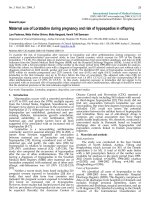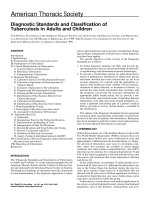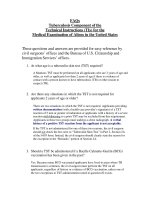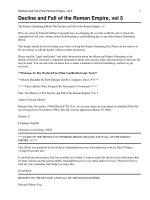Fundamentals and Applications of Biophotonics in Dentistry Vol.4 doc
Bạn đang xem bản rút gọn của tài liệu. Xem và tải ngay bản đầy đủ của tài liệu tại đây (16.45 MB, 341 trang )
Fundamentals and Applications of
Biophotonics in Dentistry
Anil Kishen
Anand Asundi
Imperial College Press
Vol.4
Series on Biomaterials and Bioengineering
Fundamentals and Applications of
Biophotonics in Dentistry
SERIES ON BIOMATERIALS AND BIOENGINEERING
Series Editors: A W Batchelor (Monash Univ. Sunway Campus Malaysia Sdn Bhd)
J R Batchelor (UK)
Margam Chandrasekaran (Singapore Institute of Manufacturing
Technology, Singapore)
Vol. 1: An Introduction to Biocomposites
by Seeram Ramakrishna (National University of Singapore, Singapore),
Zheng-Ming Huang (Tongji University, China),
Ganesh V Kumar (National University of Singapore, Singapore),
A W Batchelor (Monash University Malaysia, Malaysia)
Joerg Mayer
(TECIM,
Switzerland)
Vol. 2: Life-Enhancing Plastics: Plastics and Other Materials in Medical Applications
by Anthony Holmes-Walker (Biolnteractions Ltd, UK)
Vol. 3: Service Characteristics of Biomedical Materials and Implants
by Andrew W Batchelor (Monash University Malaysia, Malaysia) and
Margam Chandrasekaran (Singapore Institute of Manufacturing Technology,
Singapore)
Vol.4
Series on Biomaterials and Bioengineering
Fundamentals and Applications of
Biophotonics in Dentistry
Anil Kishen
National
University
of
Singapore,
Singapore
Anand Asundi
Nanyang
Technological
University,
Singapore
Jft^
Imperial College Press
Published by
Imperial College Press
57 Shelton Street
Covent Garden
London WC2H 9HE
Distributed by
World Scientific Publishing Co. Pte. Ltd.
5 Toh Tuck Link, Singapore 596224
USA office: 27 Warren Street, Suite 401-402, Hackensack, NJ 07601
UK office: 57 Shelton Street, Covent Garden, London WC2H 9HE
British Library Cataloguing-in-Publication Data
A catalogue record for this book is available from the British Library.
FUNDAMENTALS AND APPLICATIONS OF BIOPHOTONICS IN DENTISTRY
Series on Biomaterials and Bioengineering — Vol. 4
Copyright © 2007 by Imperial College Press
All rights
reserved.
This
book,
or parts
thereof,
may not be reproduced in any form or by any means,
electronic or
mechanical,
including
photocopying, recording or any information storage and retrieval
system now known or to be
invented,
without written permission from the Publisher.
For photocopying of material in this volume, please pay a copying fee through the Copyright
Clearance Center, Inc., 222 Rosewood Drive, Danvers, MA 01923, USA. In this case permission to
photocopy is not required from the publisher.
ISBN
1-86094-704-2
Printed by Fulsland Offset Printing (S) Pte Ltd, Singapore
PREFACE
Biophotonics is revolutionizing the field of medicine, biology and
chemistry and creating a new breed of medical engineers while at the
same time getting engineers a taste of medicine. From an engineer's
perspective, biophotonics is the application of photonics - the technology
of generating and harnessing packet of light energy called photons - to
image, detect and manipulate biological materials. In biology the
understanding of molecular mechanisms, function of proteins and
molecules has seen great new advances. In biomedical engineering
detection, diagnoses and treatment targeting both macro-objects like the
teeth or bone as well as micro-objects such as bacteria have seen better
understanding through the development of new tools. There is another
school of thought, albeit much smaller that defines biophotons as a
quantum of light that is permanently and continuously emitted by all
living systems. For example, humans emit radiation similar to a
blackbody with maximum power being emitted at a wavelength of about
10 um.
Regardless of definition, biophotonics is a multi-disciplinary field that
bridges engineering, the sciences and medical fields. This diversity of
sciences and technologies usually makes for challenging and interesting
projects - that could be driven by engineers and clinicians alike.
However, there is still the need that clinicians understand some concepts
in photonics while engineers get a feel for medical and bio-chemical
sciences. Towards this end, this book is written by persons from different
fields such as engineering, sciences and medical field.
The book is roughly divided into two sections - the first introduces
the readers to some basic concepts in the field of biophotomechanics. As
the name suggests, this topic looks at the use of optical methods (photo)
for the study of mechanical behaviour (mechanics) of biological objects
v
VI
Preface
in the macro-scale such as teeth and bone. The next chapter introduces
some recent techniques on bioimaging such as fluorescence microscopy
and optical coherence tomography amongst others. Chapter 4 introduces
spectroscopy - a erstwhile tool in biophotonics while chapter five deals
with lasers and laser tissue interaction. Finally Chapter 6 provides an
introduction to Photodynamic therapy a growing technology for targeted
application of photonic radiations.
The second half of the book applies some of these basic concepts to
the field of dentistry to highlight some of the features and adaptation of
photonics in this area. Dental photomechanics provides an understanding
of mechanical and thermal characteristics of dentine and permits a better
understanding of the causes of damage and failure of certain treatments.
Chapter 8 uses spectroscopic methods specifically Micro-Raman
spectroscopy for a better understanding of the materials aspects of
dentine and adhesives. The next chapter on Dental and Oral Optics
describes tools and techniques for imaging and optical properties of
dentine and enamel. The final chapter on fiber optic sensors explores
new sensor development for effective and fast ways of detecting and
diagnosing oral bacteria.
We,
as editors, feel that the book would be just as informative for
final year undergraduate, graduate students in bioengineering as it would
to clinicians and dental surgeons to gain a better understanding of a
process or treatment.
Anil Kishen and Anand Asundi
CONTENTS
Preface
Chapter 1
Chapter 2
FUNDAMENTALS
Introduction
1.1.
1.2.
1.3.
1.4.
1.5.
Introduction
Definition and Significance
Classification of Biophotonics in Dentistry
1.3.1. Diagnostic
1.3.2.
Therapeutic
1.3.3.
Research
Future Opportunities
Scope of this Book
Photomechanics
2.1.
2.2.
2.3.
2.4.
Introduction to Mechanics
2.1.1.
Force and Stress
2.1.2. Deformation and Strain
2.1.3.
Stress-Strain Equations
Basic Optical Engineering
2.2.1.
Geometric Optics
2.2.2. Physical (Wave) Optics
2.2.3.
Photonics
. Photomechanics
2.3.1.
Moire and Grid Methods
2.3.2. Speckle Methods
2.3.3.
Photoelasticity
2.3.4. Holography
2.3.5.
Digital Photomechanics
Concluding Remarks
1
2
3
3
4
5
7
8
9
10
13
16
16
17
19
27
30
31
40
46
54
58
60
VI!
Vlll Contents
Chapter 3 Biomedical Imaging
3.1.
Introduction 64
3.2. Non-Linear Optical Microscopy (NLOM): 65
Multiphoton Excited Fluorescence (MPEF)
and Second Harmonic Generation (SGH)
3.2.1.
Principles of NLOM 66
3.2.2. Development and Applications 69
of NLOM
3.2.3.
NLOM in Dentistry 72
3.3.
Optical Coherence Tomography (OCT) 73
3.3.1.
Principles of OCT 74
3.3.2. Developments and Applications 75
of OCT
3.3.3.
OCT in Dentistry 80
3.4. Coherent Anti-Stokes Raman Scattering 82
(CARS) and Modulated Imaging (MI)
3.5.
Fluorescence Contrast Enhancement 85
3.6. Concluding Remarks 87
Chapter 4 Spectroscopy
4.1.
Introduction 93
4.2.
Molecular Orbitals and Transitions 94
4.3.
Transition Dipole Moment 99
4.4.
Spin Selection Rule 100
4.5.
Franck-Condon Principle 102
4.6.
Jablonski Diagram 104
4.7.
Stokes Shift 107
4.8.
Spectrophotometry 108
4.9.
Fluorescence Intensity and Lifetime 110
4.10. Spectrofluorimetry 112
4.11.
Fluorescence Quenching 115
4.12.
Fluorescence Resonance Energy Transfer 116
(FRET)
4.13.
Fourier Transform Infrared (FTIR) 117
Spectroscopy
4.14. Concluding Remarks 120
Contents
IX
Chapter 5 Lasers and Laser Tissue Interaction
5.1.
Introduction 123
5.2. Laser Basics 124
5.2.1.
Characteristics of Lasers 126
5.3.
Light Propagation in Tissue 128
5.4. Optical Imaging and Diagnosis 131
5.4.1.
Optical Imaging 131
5.4.2. Optical Spectroscopic Diagnosis 133
5.5.
Optical Processing of Tissue 141
5.5.1.
Photothermal Effects 142
5.5.2. Photomechanical Effects 144
5.5.3.
Photochemical Effects 144
5.5.4. Applications of Laser Processing 145
of Tissue
5.6. Concluding Remarks 148
Chapter 6 Mechanisms and Applications of Photodynamic
Therapy
6.1.
Historical Background 154
6.2. Photosensitizers 155
6.3.
Light Applicators 156
6.4. PDT Mechanisms 161
6.4.1.
Photophysics and Photochemistry 161
6.4.2. Biological Effect 162
6.5.
PDT Dosimetry 166
6.6. Progress in Clinical Application 167
6.6.1.
Non-Malignant Diseases 168
6.6.2. Malignant Diseases 169
6.7. PDT in Dentistry 175
6.7.1.
Technical Challenges 175
6.7.2. Current Status 176
6.8. Concluding Remarks 177
X Contents
APPLICATIONS
Chapter 7
Chapter 8
Dental Photo-Biomechanics
7.1.
7.2.
7.3.
7.4.
7.5.
Introduction
Photoelasticity
7.2.1.
Introduction
7.2.2. Photoelastic Models
7.2.3.
Polariscope
7.2.4. Photoelastic Fringe Analysis
7.2.5.
Applications of Photoelasticity in
Dentistry
Moire Interferometry
7.3.1.
Introduction
7.3.2. Specimen Grating and Moire
Interferometer
7.3.3.
Applications of Moire Technique
in Dentistry
Electronic Speckle Pattern Correlation
Interferometry
7.4.1.
Introduction
7.4.2. ESPI Experimental Arrangement
7.4.3.
Applications of ESPI Technique in
Dentistry
Concluding Remarks
Micro-Raman Spectroscopy: Principles and
Applications in Dental Research
8.1.
8.2.
8.3.
8.4.
8.5.
Introduction
Breakdown of Composite
Repair/Replacement Materials
Material/Tissue Interface
Brief Introduction to Raman Spectroscopy
Applications of Micro-Raman Spectroscopy
in Dental Research
8.5.1.
Characterization of the Smear Layer
8.5.2.
Characterization of Smear Debris
183
184
184
185
186
189
192
195
195
196
197
200
200
201
201
207
209
210
211
212
215
215
224
Contents XI
8.5.3.
Quantifying Reactions at the 226
Adhesive/Dentin Interface
8.5.4.
Investigation of Adhesive Phase 231
Separation
8.6. Concluding Remarks 239
Chapter 9 Dental and Oral Tissue Optics
9.1.
Introduction 245
9.2. Continuous Wave Light Interaction with 248
Tissues
9.3.
Time-Resolved Diffusion Measurements 253
9.4. Optical Properties of Dental Enamel and 256
Dentin
9.4.1.
Structure of Enamel and Dentin 256
9.4.2. Spectral Properties of Enamel and 259
Dentin
9.4.3.
Scattering Properties of Enamel 261
9.4.4. Scattering Properties of Dentin 263
9.4.5.
Waveguide Effects 264
9.5.
Propagation of Polarized Light in Tissues 266
9.5.1.
Basic Principles 266
9.5.2. Transillumination Polarization 268
Technique
9.5.3.
Backscattering Polarization Imaging 269
9.5.4. In-Depth Polarization Spectroscopy 272
9.5.5.
Superficial Epithelial Layer 273
Polarization Spectroscopy
9.5.6. Polarization Microscopy 274
9.5.7. Digital Photoelasticity Measurements 274
9.6. Optothermal Radiometry 275
9.7. Thermal Imaging 279
9.8.
Coherent Effects in the Interaction of Laser 280
Radiation with Tissues and Cell Flows
9.9. Dynamic Light Scattering 283
9.9.1.
Quasi-Elastic Light Scattering 283
9.9.2. Dynamic Speckles 284
9.9.3.
Full-Field Speckle Technique- LASCA 285
9.9.4. Diffusion Wave Spectroscopy 286
9.9.5.
Experimental Studies 287
Xll
Contents
9.10. Coherent Backscattering 287
9.11.
Optical Coherence Tomography (OCT) 288
9.11.1.
Introduction 288
9.11.2. Conventional (Time-Domain) OCT 289
9.11.3.
En-Face OCT 290
9.11.4. DopplerOCT 291
9.11.5. Polarization Sensitive OCT 292
9.11.6. Optical Coherence Microscopy 294
9.12. Concluding Remarks 295
Chapter 10 Fiber Optic Diagnostic Sensors
10.1.
Introduction 301
10.2.
Fiber Optics in Diagnosis 302
10.3.
Fiber Optic Diagnostic Sensors: Principles 304
10.4.
Direct Fiber Optic Sensors: Principles 304
10.4.1.
Direct Fiber Optic Physical Sensors 306
10.4.2.
Direct Fiber Optic Chemical 306
Sensors
10.5.
Indirect Fiber Optic Sensors: Principles 309
10.5.1.
Indirect Fiber Optic Physical 310
Sensors
10.5.2.
Indirect Fiber Optic Chemical 313
Sensors
10.6.
Biosensors 316
10.7.
Applications of Fiber Optic Diagnostic 319
Sensors in Dentistry
10.8.
Concluding Remarks 326
CHAPTER 1
INTRODUCTION
Anil Kishen
Biophotonics Laboratory, Faculty of Dentistry Laboratory,
National University of Singapore, Republic of Singapore
E-mail:
1.1 Introduction
Photonics is a light based optical technology that is considered as the
leading technology for the new millennium. During the last 50 years,
there has been many breakthroughs in photonics which laid foundation
for its wide range of applications in health care. Most applications of
photonics in health care were based on various types of light and
different types of photon-tissue interactions. Application of photonics
based techniques offer several specific advantages such as rapidity,
sensitivity, specificity, inexpensive and non-invasive (needle less). It has
been observed that many diseases of the mouth are accompanied by
characteristic changes in the tissue structure. Some of the typical
examples include dental caries, non-carious lesions in teeth, gingivitis,
periodontitis, precancerous lesions and tumors of the oral tissues.
Dentistry has traditionally depended on contemporary science and
technology for improvement in diagnostic tools and advancement in
treatment options. However, the impact of photonics in clinical Dentistry
has been significantly less than in clinical Medicine and Surgery.
Current dental practice has been emphasizing more on (1) early
diagnosis and preventions of common oral diseases and (2) to conserve
tooth structure as much as possible during restorative procedures. Thus
Atraumatic and Non Invasive Treatment (ANIT) modalities have been
the key thrust in Dentistry today. Keeping in mind the tremendous
l
2 Fundamentals and Applications of Biophotonics in Dentistry
potential of optical technology to provide high sensitive tissue
information non-invasively, and the ability to induce localized and
specific tissue changes, this should be the foremost technology to
embrace for advancement in dentistry. In addition, research has
highlighted saliva as a potential source of diagnostic markers to monitor
the health status of the whole body. Saliva is increasingly used as an
investigational aid in the diagnosis of diseases, such as dental caries,
HIV, diabetes mellitus, oral cancer and breast cancer. Saliva meets all the
requirements for a non-invasive, accessible and highly efficient
diagnostic medium. When compared with the procedures for collecting
blood, the use of saliva is less invasive and less traumatic to the patients.
The most important benefit of light based diagnostic methods is their
capability to detect clinically relevant information much early before
actual clinical signs and symptoms appear in the patient. This allows
photonics based techniques not only to be non-invasive during
application but also detect disease associated tissue changes very early.
Early detection of disease process will enable clinicians to carry out
preventive treatment measures or minimally invasive treatment
procedures that are less traumatic and cost effective.
1.2 Definition and Significance
Photonics include all light-based (optical) technology that is hailed as
the dominant technology of this millennium. Biophotonics is a
multidisciplinary category under photonics, which involves the fusion of
photonics and biomedical sciences. Biophotonics defined as the science
of generating and harnessing light (photons) to image, detect and
manipulate biological materials. It is applied in Medicine and Dentistry
to understand, diagnosis and treatment of diseases. Biophotonics mainly
involves the interaction between light with biological tissues, and is used
to study biological tissues and biological processes at different scales that
ranges from micro to nano-levels. Biophotonics integrates lasers,
photonics, nanotechnology and biotechnology. This integrated approach
provides new dimension for diagnostics and therapeutics. This rapidly
growing new discipline will have a major impact on health care.
Introduction
3
Light has been used as a therapeutic agent and experimental approach
for many centuries. The major use of light for therapeutic applications in
health care sciences was noticeably initiated after the development of
lasers in 1960. Invention of lasers, a concentrated source of
monochromatic light has revolutionized photonics. Most of the earlier
clinical studies in dentistry were conducted with high energy lasers such
as Ruby laser ((1963), C02 (1968), YAG (1974), Argon (1977),
Nd:YAG (1977) and Q-switched YAG (1980).
Last decade saw the advent of semiconductor diode lasers which are
referred to as soft lasers. These lasers are compact, low cost device
which have very high electrical and optical efficiency. In Dentistry the
soft lasers have been used for acceleration of wound healing, enhanced
remodelling and repair of bone, restoration of normal neural function
following injury, normalization of abnormal hormonal function and
modulation of the immune system. Although low-level light offers many
potential advantages in Dentistry, further research is warranted before
serious clinical applications.
1.3 Classification of Biophotonics in Dentistry
Biophotonics in Dentistry is crucial for the early detection of diseases,
to carry out more effective minimally-invasive targeted-therapies and to
restore diseased tissues functionally and esthetically. Different
applications of biophotonics in health care are shown in Fig. 1.1.
Biophotonics in Dentistry can be broadly categorized into (1) research
and (2) clinical applications (see Fig. 1.2). Under clinical application
they can be further subdivided into (2A) diagnostics and (2B)
therapeutics.
1.3.1 Diagnostic
Low-energy light interacting with tissue gives rise to a characteristic
luminescence, which provides information on different clinically useful
parameters such as blood flow, pH and oxygen content. In addition, it
4 Fundamentals and Applications of Biophotonics in Dentistry
may also provide information on the physiologically and pathologically
induced biochemical changes.
1.3.2 Therapeutic
Thermal interaction: In this process heat generated by the high-
energy laser light is used to disrupt tissues. This process will
mechanically induce coagulation, vaporization, carbonization and
melting. Ruptured blood vessels are sealed by the laser induced
coagulation of blood. The heat generated by laser beam on the focused
tissue can be also used to weld tissue segments instead of using sutures.
Further, high energy lasers are also used to cut-through tissues.
Photodynamic Therapy: This method uses light to trigger chemical
reactions in the body for therapeutic applications. A photosensitizing
agent is utilized to achieve the photodynamic effect. Photodynamic
therapy is also called as photoradiation therapy, phototherapy, or
photochemotherapy.
Photo-biostimulation: In this method extremely low-power light is
used to induce photochemical effects on tissues. A low-powered laser
procedure does not produce heat and therefore does not damage
biological tissues; it stimulates the tissues and promotes healing by
penetrating deep into the tissues initializing the process of photochemical
effect. Photo-biostimulation is applied in Dentistry for many applications
such as post extraction edema, sensitive teeth, gums and benign mouth
lesions.
Bioimaging: Optical and x-ray imaging has influenced the practice of
dentistry dramatically. Reconstruction of images in both two and three-
dimensions has allowed better visualization of models and disease
processes, allowing quantification of disease changes over time, thus
assisting the treatment planning decisions and improving patient care.
Some of these innovations are in the research and development stage.
Bioimaging finds application in oncology, inflammatory processes,
wound healing, pharmacokinetics, pharmacodynamics, toxicology,
Introduction
5
infectious disease, gene expression and more. Furthermore, new concepts
of non-invasive imaging (optical biopsy) rely on better understanding of
the signal's origin, both "native" and exogenous.
1.3.3 Research
Photomechanics: Much research in dentistry is directed to
understand the stress-strain states in biological and artificial structures
(restorations and prosthesis). Photomechanical experiments are optics
based experiments used to study the material property gradients in
biological materials and the stress-strain distribution in tooth and
supporting bone structures. These high sensitive experimental techniques
are used to extrapolate clinically relevant material properties within
dental structures and within biological interfaces. Photoelasticity, Moire
interferometry and Electronic Speckle pattern interferometry are some of
the most commonly employed optical techniques in dental biomechanics.
In the past analyzing optical fringes to deduce clinically useful
experimental data was considered tedious and time consuming. However,
with the recent advances in digital image processing systems, analysis of
optical fringes has been robust and efficient.
Spectroscopy: A spectrum is a representation of the electromagnetic
radiation which is absorbed or emitted by a sample. The qualitative
applications of absorption spectrometry depends on the fact that a given
molecular species absorbs light only in the specific region of the
spectrum, and in varying degrees, characteristic of that particular species.
Such a display is called an absorption spectrum of that molecular species
and serves as a fingerprint for identification purpose. UV-Visible
spectroscopy monitors the electronic states of the molecules, while an
infrared spectroscopy determines changes in the vibrational states of the
molecules. These techniques are very valuable for the non-invasive
testing (without needles) of biochemical substances for diagnostic and
therapeutic purposes. Raman spectroscopy, which is based on Raman
scattering, measures the inelastic scattering when high-energy photon
interact with a molecule (or crystal lattice). This analytical technique is
finding significant application in pharmaceutical industry. There is a
6 Fundamentals and Applications of Biophotonics in Dentistry
growing interest in single cell, tissue, organ level measurements as
applied to basic physiology, non-invasive diagnostics, and in vivo
studies.
Fiber-optic sensors: Optical fibers in health care sciences have come
a long way; however, they still need further improvements. Fiber optics
offers the advantage of flexibility of beam manipulation. In the past fiber
optics was used mostly as an optical conduit to illuminate inaccessible
regions and to conduct high-energy lasers to specific tissue site for
cutting. Recently, many fiber optic based sensors are being developed
with intentions to provide a safe, rapid and non-invasive testing of
clinically relevant physiological variables. The fiber optic based sensor
offers advantages such as electrical isolation, physical flexibility and
needless of electrical power for driving the sensor unit. Additionally,
they find application in designing customized probes that are tailored
for specific applications. These probes combine the advantage of
spectroscopic techniques with fiber optics.
Bioimaging
3D imaging
Nanophosphores
Drug tracking
Light guided / activated
therapy
Photodynamic therapy
Light activated therapy
Photomodulation of tissues
Drug delivery
Bioadhesives
A K
/ DIAGNOSTICS \
N V
A K
/ THERAPEUTICS \
N V
Optical diagnostic devices
Fiber optic sensors
Biosensors
Drug and tissue
characterization
Light based devices
Medical laser
Tissue engineering
Tissue welding
Fig. 1.1. Applications of biophotonics for health care.
Introduction
» Diagnostic
Physico-chemical sensors
Laser induced fluorescence
Autofluorescence
Fiber-optic sensors
• Therapeutic
Thermal interaction
Photodynamic Treatment
Photo-biostimulation
Bioimaging
MPOOS
MAXILLOFACIAL REGION
• Research
Photomechanics
Optical spectroscopy
Fiber-optic sensors
Fig. 1.2. The comprehensive multidisciplmary scope of biophotonics in dentistry.
1.4 Future Opportunities
Dental practitioners have been traditionally plagued with different
problems pertaining to the diagnosis and treatment of oral diseases.
Biophotonics is an emerging technology that promises to have a broad
and significant impact on health care. In the past decade, key
technologies such as (a) compact lasers, (b) CCD detectors, (c) volume
holographic elements and (d) easy-to-use computing platforms combined
with fiber-optic coupled instrumentation has developed many diagnostic
and therapeutic instruments in health care. Rapid detection and non-
invasive tissue modulation are the most important advantages of
photonics based methods. These methods allow early detection of
diseases and implementation of preventative or minimally invasive
treatment regimes that avert drastic tissue damage. Currently,
biophotonics is entering a new era of rigorous clinical testing and
evaluation. As photonics find major application in health care, it is
particularly important that the basic principles and potential pitfalls of
technology is also understood. Although optical spectroscopy may one
8 Fundamentals and Applications of Biophotonics in Dentistry
day replace some of the conventional clinical techniques, it is important
to combine the advantages of photonics with lessons learned by the
clinicians in the past. This approach will enable us to develop clinically
useful technologies for better health care management.
Biophotonics offers remarkable prospectus for both clinical
applications and fundamental research. In the future biophotonics is
anticipated to play a major role in creating new technologies for
significant health care benefits and immense commercial potential for
different biomedical industries. Future opportunities with biophotonics
are:
development and testing of multiple-analyte based nano-probes,
optical biosensors for infections and cancers, in vivo optical biopsy,
tissue welding, tissue contouring and regeneration, in vivo imaging of
human subjects, real-time monitoring of drug delivery and action. All
these technological aids should be supported by long-term clinical
evaluations.
1.5 Scope of this Book
The aim of this book is to provide a basic understanding of broad range
of topics for individuals from different backgrounds to acquire minimum
knowledge for research and development in biophotonics. The chapters
in this book is sorted under two major categories, the first category
describes the fundamental aspects of photonics such as Photomechanics,
Biomedical Imaging, Lasers and laser-tissue interaction, spectroscopy
and Photodynamic therapy. The second category describes the
applications of biophotonic, especially with relevance to dentistry.
Dental Photobiomechanics, Raman Spectroscopy, dental tissue optics
and fiber optic diagnostic sensors are dealt under this category.
References
1.
G.A. Catone, C.C. Ailing, Laser applications in Oral and Maxillofacial Surgery, WB
Saunders Company: London (1997).
2.
A. Katzir. Lasers and optical fibers in medicine, Academic Press, Inc: New York
(1993).
3.
P.N. Prasad. Introduction to Biophotonics. Wiley Interscience Inc., New Jersey
(2003).
CHAPTER 2
PHOTOMECHANICS
Anand Asundi
School of Mechanical and Aerospace Engineering,
Nanyang Technological University
Nanyang Avenue, Singapore 639798
E-mail: sg
Photomechanics is the application of optical methods (Photo) to solve
problems in mechanics. This field has been growing steadily over the
past couple of decades especially with the advent of low cost light
sources, detectors and CCD cameras and image processing methodology.
This chapter has been divided into 8 sections starting with introduction to
the field of mechanics and optics. A good understanding of the basic
principles of the two pillars of photomechanics would enable easy
application in a wide variety of situations. Following this introduction,
specific techniques such as Moire and Grating methods, Photoelasticity,
Speckle and Holography are highlighted. The final section looks at the
recent advances in Digital Photomechanics, which has made enormous
strides in the last decade and has all but made obsolete the ubiquitous
photographic film.
2.1 Introduction to Mechanics
In this chapter, the emphasis is primarily on solid mechanics, which is
the area that deals with the response of objects to external stimuli such as
force, temperature, etc. Furthermore, the treatment is based on the more
practice-based strength of materials approach. In the strength of materials
approach, the starting point is the entire structure under the action of
external forces. The various components of the structure are then broken
down into sub-systems while maintaining the overall equilibrium of the
9
10 Fundamentals and Applications ofBiophotonics in Dentistry
object. Hence there are few standard geometric and loading conditions
which form the basis of
all
complex objects and loading systems.
2.1.1 Force and Stress
External forces acting on a body may be due to mechanical loads or
as support reactions. Under the action of these forces, the body is said to
be in equilibrium if the sum of forces and sum of moments are equal to
zero.
For a general three-dimensional case, using the standard Cartesian
coordinates, this will give rise to 6 equilibrium conditions. These
equilibrium conditions allow determination of the unknown support
reactions in statically determinate problems. If the entire structure is in
equilibrium under the action of the external forces, then any part of the
structure should also be in equilibrium. Hence, if
a
part of the structure is
isolated, the external forces on that part need to be balanced by internal
forces at the cut-section. While there are will be many possible
combinations of internal force distribution on the cut section which
satisfies equilibrium, the correct one is that which also ensures
consistency of displacement and strain distribution; i.e. compatibility
equations. The internal force is not always uniformly distributed over the
cut cross-section. Hence instead of internal force, the concept of stress
was introduced. Stress is an abstract quantity, whose basis is more
mathematical than physical.
Stress is defined as the force per unit area. If the force is acting
normal to the cross-sectional area, the stress is termed normal stress and
will be denoted as a (Fig. 2.1(a)). Subscripts are attached to this symbol
to denote the direction of stress and the direction of the normal to the
surface on which the force acts. Thus a
xx
or simply a
x
denotes normal
stress acting in the x-direction on a surface whose normal is parallel to
the x-direction. Shear stresses, on the other hand are the tangential
component of the force divided by the cross-sectional area (Fig. 2.1(b)).
Shear stress is denoted by the symbol x, with subscripts as before to
signify the direction of stress and the normal to surface on which the
stress acts. Thus x
xy
signifies shear stress acting on a plane whose normal
is the x-direction and the stress is directed in the y-direction. Thus for an
Photomechanics
11
3-D element as shown in Fig. 2.2, there will be a total of nine stress
components - three normal stresses and six shear stresses. To satisfy
moment equilibrium, the shear stresses (x
xy
= x
yx
, x^ = x
zx
and x^ = x
zx
)
are not all independent.
By convention tensile normal stresses which pull the element apart
are positive and the shear stress which causes the element to rotate in the
counterclockwise direction is positive. The above definition provides
what is referred to as local
stress.
There is also the average normal stress
- which is the total force acting normal to a surface divided by the area
on which it is acting. A similar definition follows for the average shear
stress, in which case the total force is tangential to the same area. If the
internal forces are distributed uniformly over the cross-section, then the
average stress is equal to the local stress.
(a)
(b)
Fig.
2.1.
Concept of stress.
Fundamentals and Applications of Biophotonics in Dentistry
Fig. 2.2. 3-D stress components.
A complex loading system can be simplified into four basic sub-
systems and the resultant stress is then calculated based on the
superposition of the stresses determined from each of these basic sub-
systems. The four subsystems are: axial loading, shear loading,
transverse loading or bending and torsion. The corresponding stresses for
each of
the
cases can be written as:
Axial or longitudinal Loads (P) gives rise to normal stress if the load
is applied perpendicular to the cross-section area and can be written as
P
<j - —
A
(2.1)
The axial stress can be tensile or compressive depending on the
external loads. Shear loading similarly gives shear stress which is the
load applied tangentially (V) to an area divided by the cross-section area
T =
-
V
(2.2)
A load applied transverse to the long axis of a beam gives rise to a
bending moment (M) and shear force (V) and these in turn result in
normal and shear stresses which are given as:









